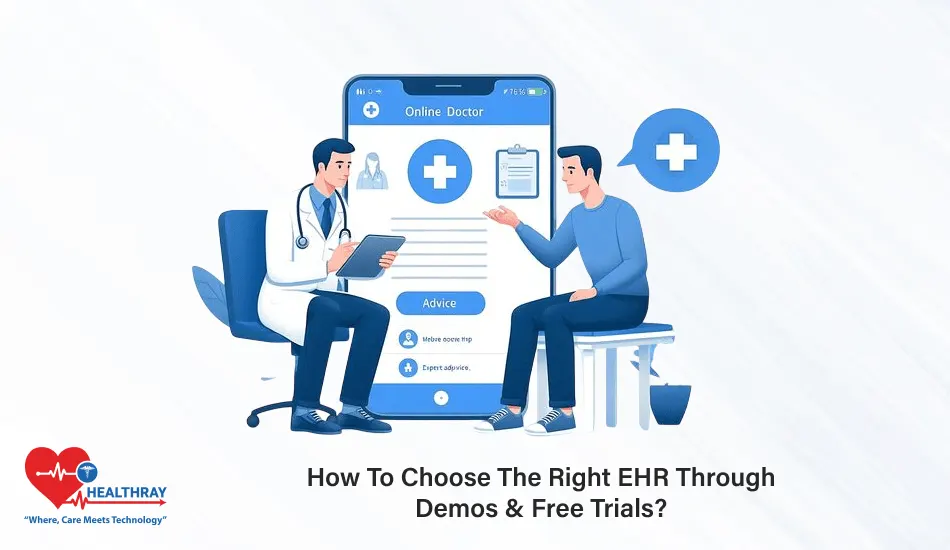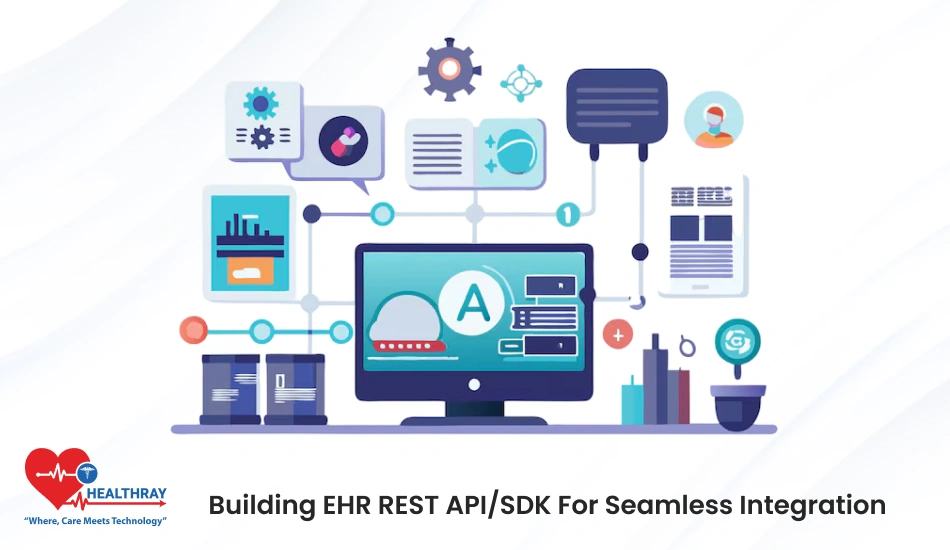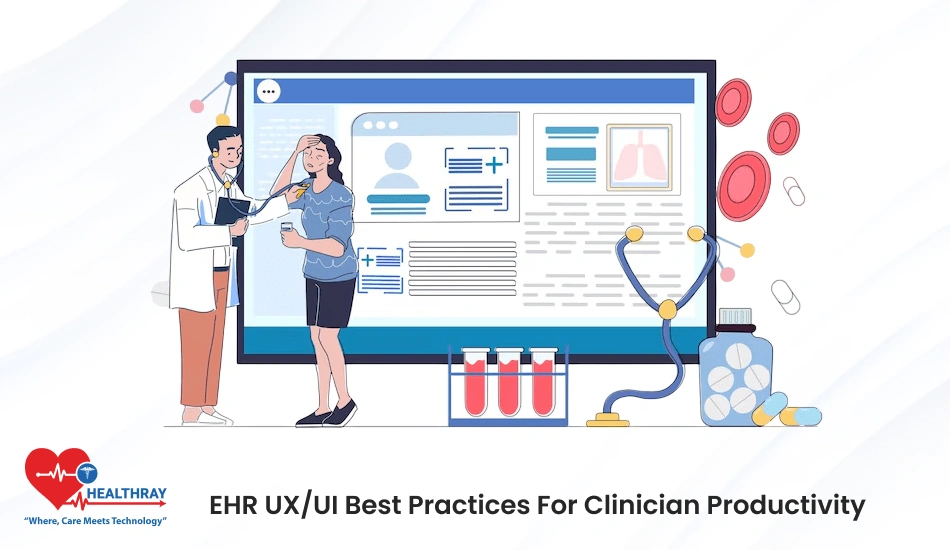Summary
A good strategy makes the selection of an EHR easy. As this article demonstrates, every EHR software has its truths, but these can come to light only when it is actually demoed and tried out. You learn what to check for, what to avoid and how to compare important features.
You also uncover red flags, smart questions, real test workflows, long-term cost insights, steps that help you choose with confidence. You get speed, support, security, workflow comfort and real value with the EHR demo & free trial guide. This blog post will allow you to determine which is the best tool for your clinic.
Introduction
It’s a daunting task to pick the right EHR, right? So, you need a clear EHR demo & free trial guide that cuts the confusion fast. There are so many that each EHR vendor says it is the best. And you want the truth, not huge promises.
With so many options, every EHR vendor claims to be the best. You want the truth, not lofty promises. You want an EHR software that works for your daily work and saves you time. That is why you have to demo and trial everything before you choose anything.
When you are looking at different EHR software, you can intuitively sense what is smooth and what is frustrating. But these initial tests reveal strengths and vulnerabilities. You see how each system handles tasks, how fast it loads, and how user-friendly it is for your team.
We will talk about each of these steps together in this blogpost. We will test features and learn what actually works. By the end, you will be able to make wise decisions regarding EHR.
What an EHR Demo Really Shows You?

An EHR demo offers an instantaneous and truthful impression of how a system functions. Specifically, you see how each screen acts, how each button reacts, and how user-friendly your team can be when going through a day’s worth of work. Consequently, you stop guessing and you start seeing facts.
Furthermore, you check how the EHR software does charting, scheduling, billing, and patient flow during the demo. Additionally, you also test how quickly the system loads and how clean the layout feels. Because you control the pace, you catch issues earlier. As a result, that added awareness allows you to make comparisons of each instrument against the work of your clinic.
In addition, you see important tools like EHR backup & disaster recovery tools too. Notably, these tools are important because they safeguard your data in a crisis. Therefore, you have to look closely.
You also use this stage to ask early cost questions. This is to become aware of the EHR ROI calculator & cost models. Hence, you see whether the numbers fit your budget.
Progressing through each screen gives you an idea of the strengths of the system. This clarity will prep you for the complete EHR demo & free trial guide you follow afterwards.
Why Free Trials Are Even Better?
A free trial, in contrast, gives you something more real than a demo. Specifically, you use EHR software in the daily workflow of your clinic. Moreover, you try actual jobs, process actual records, and verify actual results. Consequently, this experience provides you with a hands-on understanding of everything you need to know.
Furthermore, you put it to the test during peak times. As a result, you see how quickly your squad adapts. Additionally, you observe how the tool performs under pressure. Because you use it natively, you are able to identify the good parts and the weak parts quickly. Thus, this honest testing prevents you from making big mistakes.
In addition, you also explore EHR backup & disaster recovery options during the trial. For instance, you examine how alerts sound, how the system backs up data, and how quickly recovery occurs. Ultimately, these features help to protect your clinic. Therefore, you have to trust them all before you sign anything.
In real time, you also calculate actual numbers with your EHR ROI calculator & cost models during these trials. You think about what cost, time saved, staff efficiency and daily workload all mean.
And, most importantly, free trials help to prepare you for the future of EHR systems. You see how the tool upgrades, how AI features behave and how the vendor plans growth. This information will help you in making a right decision with your EHR demo & free trial guide in hand.
Step-by-Step EHR Demo & Free Trial Guide: How to Choose the Right One?

Here are some of steps for choosing the right EHR:
Step 1: List your must-have features
Start with clarity. First, you need to know what your clinic needs. So, you should make a list of must-have features. These features include charting, billing, scheduling, e-prescribing, reporting, etc. Moreover, because every clinic works differently, your list will help you quickly eliminate the wrong tools.
In addition, you should also list features like EHR backup & disaster recovery. Early in the evaluation process, many clinics lose sight of this. This one feature, however, helps safeguard your practice from lost data. Consequently, keep it on your list of essentials to have.
While compiling your list, keep your long-range goals in mind. Specifically, consider the future of EHR systems. Think automation, AI support, analytics, and remote access. Indeed, these instruments define the next decade.
Ultimately, your list organizes the entirety of the EHR demo & free trial guide. As a result, you measure each tool up against this list, and you stay on task.
Step 2: Prepare real test cases
Then, schedule real-life situations. These scenarios have to fit your business. To begin with, start with straightforward use cases like registering new patients, follow-up appointments, and billing updates.
Next, put the EHR software through the click test. In this phase, see if the data saves quickly. Additionally, see how your staff flows through the process. Moreover, you should test alerts, templates, and shortcuts. Ultimately, these small details mean huge differences in actual work.
In addition, also test the built-in security of the data. Specifically, consider EHR backup & disaster recovery during these. For example, test how the system alerts you, how often backups run, and how quickly you can recover. Consequently, these steps protect your clinic.
Ultimately, this is at the heart of your EHR demo & free trial guide in these actual test cases because they reveal real workflow challenges.
Step 3: Check speed, support, and stability
Speed is of the essence every day. Moreover, slow software increases stress. Therefore, test loading time, navigation speed, and report generation. Additionally, test them, too, during busy hours if you can.
Furthermore, support is even more critical. During your trial, ask real questions. Also watch out how long the support team takes to respond. In addition, see how helpful the answers feel. In a crisis, every second is precious.
Moreover, you need to run tests of system stability as well. Specifically, some systems crash under heavy use, while others freeze during big uploads. Thus, push the EHR software with a real workload. This is how you learn the truth.
Additionally, consider long-term costs using the EHR ROI calculator & cost models. In fact, these types of models help you determine if the system is saving money or adding on cost. Therefore, you need long-range vision.
Finally, this step allow the EHR demo & free trial guide to go into more details.
Step 4: Compare trial notes with your goals
Compile your notes after trying a few tools. Next, compare each trial to your initial must-have list. In doing so, consider speed, accuracy, staff comfort, and workflow. Consequently, these notes reflect reality.
Furthermore, use numbers from your EHR ROI calculator & cost models to compare long-term value. Specifically, compare cost per user, training cost, data migration cost, and maintenance costs. Indeed, figures never lie.
Additionally, you also have to compare their preparation for the future of EHR systems. Therefore, invest in AI, automation, and other technologies that can be easily upgraded. Ultimately, this decision protects your clinic for years.
This step gives your EHR demo & free trial guide clarity on every detail.
Step 5: Choose the one that works for you
Pick the system that works for your actual workflow. You want comfort, speed, ease of adoption. You want strong security, strong data protection. But, you want reliable EHR backup & disaster recovery tools.
You also want a system that grows with you and your clinic. New tools and new demands will define the future of EHR systems. So, choose a vendor that supports this future.
Draw upon your figures, notes and lived experience. And trust your final decision. Because you followed the EHR demo & free trial guide step by step, now you can choose with confidence.
Learn more: Top 10 EHR Software Vendors in India
Red Flags to Watch During Demos & Trials
Be aware that during your tests you will need to pay attention to several red flags. These signs alert ahead of time and protect your clinic.
- Slow loading time: Slow software increases stress and slows your team. It is bad for productivity and is frustrating for everyone. You must stay away from this.
- Confusing or cluttered screens: Confusing layouts waste time. If your team struggles, the system will not improve later. You want screens that are clean and simple.
- Weak customer support: Slow customer support can be dangerous in an emergency. If the support team is slow right now, they will be slow when you buy. You want quick, helpful answers.
- Missing core features: If the EHR software does not contain charting, scheduling, reporting or e-prescribing, it cannot support your clinic. Missing tools cause everyday workflow problems.
- Missing EHR backup and disaster recovery: Lack of adequate backup technology can put your practice in a vulnerable position. You need to test backup speed, restore ability and safety of the data. Robust recovery will safeguard your business during any disaster.
Questions to Ask During the Demo
Below is a simple table with key questions and reasons:
| Sl. No. | Question | Why You Should Ask It |
| 1 | How fast is onboarding? | Speed in onboarding conserves time and relieves staff pressure. |
| 2 | What is the total estimated cost? | Clear costs avoids any surprises later. |
| 3 | How secure is patient data? | Strong security also keeps your clinic secure from breaches. |
| 4 | Can it grow with your clinic? | Sustainable systems enable long-term viability. |
| 5 | How robust is the EHR backup & disaster recovery? | Backups are your safeguard against disaster. |
| 6 | How simple is daily navigation? | Simpler screens cut down on errors and increase speed. |
| 7 | How fast does the system load? | Quick loading enhances productivity during peak periods. |
| 8 | What training do you provide? | Adequate training allows your team to adapt quickly. |
| 9 | How easy is template customization? | Templates provide consistency and are time saving. |
| 10 | How often do you update features? | Regular updates keep you prepared for the future of EHR systems. |
| 11 | How strong is your customer support? | Fast support helps keep you safe in urgent situations. |
| 12 | How well does your EHR software integrate? | Smooth integrations make it easier and less error prone. |
| 13 | How transparent are your EHR ROI calculator & cost models? | Simple models help you see real value. |
| 14 | How do you handle data migration? | Safe migration protects patient history and records. |
| 15 | What mobile features do you offer? | Mobile tools allow your staff to work quickly anywhere. |
Conclusion
It becomes simpler to find the appropriate EHR when there is a process to follow. You test features, compare workflows and study real performance. And with the EHR demo & free trial guide, you see the truth behind every system.
You also consider cost, growth, security and daily comfort. You test EHR software, evaluate EHR backup & disaster recovery, and research the future of EHR systems. And with this wisdom, you choose the EHR that supports your clinic, your staff and your growth.





